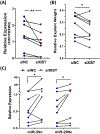The in vivo effects of knockdown of long non-coding RNA XIST on fibroid growth and gene expression
- PMID: 39475327
- PMCID: PMC12097159
- DOI: 10.1096/fj.202401982R
The in vivo effects of knockdown of long non-coding RNA XIST on fibroid growth and gene expression
Abstract
The role of long non-coding RNAs in fibroid pathogenesis remains largely unexplored. In a previous study, we found elevated XIST (X-inactive specific transcript) levels in fibroids, which sponged miR-29c and miR-200c, leading to the overexpression of their target genes. This study aimed to assess the therapeutic potential of XIST downregulation in fibroid treatment. Ovariectomized SCID (severe combined immunodeficiency) mice were implanted with fibroid tumors transduced with XIST siRNA or a control via lentivirus. After 1 month, animals were sacrificed and the xenografts were removed for further analysis. XIST knockdown reduced tumor weight by 15% and increased miR-29c and miR-200c expression by 3.9-fold and 2.2-fold, respectively. The mRNA expression of miR-29c targets (COL3A1, TGF-β3, CDK2, SPARC) and miR-200c targets (CDK2, FN1, TDO2), as well as PRL, E2F1, and EZH2, was significantly decreased. Protein abundance of collagen, COL3A1, FN1, CDK2, SPARC, and EZH2 was also reduced. IHC analysis of xenograft sections using the markers of Ki67 for cell proliferation and cleaved caspase 3 for apoptosis showed decreased cell proliferation and no changes in apoptosis in the XIST knockdown xenografts. This analysis also revealed decreased collagen and E2F1 staining nuclei in the XIST knockdown xenografts. These results indicate that downregulation of XIST in fibroids has beneficial therapeutic effects, by reducing tumor growth and the expression of genes involved in cell proliferation, inflammation, and extracellular matrix regulation.
Keywords: ECM; XIST; cell proliferation; fibroid; inflammation; miR‐200c; miR‐29c.
© 2024 The Author(s). The FASEB Journal published by Wiley Periodicals LLC on behalf of Federation of American Societies for Experimental Biology.
Conflict of interest statement
DISCLOSURES
The authors declare that they have no known competing financial interests or personal relationships that could have appeared to influence the work reported in this paper.
Figures






Similar articles
-
Targeting the long non-coding RNA MIAT for the treatment of fibroids in an animal model.Clin Sci (Lond). 2024 Jun 19;138(12):699-709. doi: 10.1042/CS20240190. Clin Sci (Lond). 2024. PMID: 38817011 Free PMC article.
-
Functional role of the long noncoding RNA X-inactive specific transcript in leiomyoma pathogenesis.Fertil Steril. 2021 Jan;115(1):238-247. doi: 10.1016/j.fertnstert.2020.07.024. Epub 2020 Oct 15. Fertil Steril. 2021. PMID: 33070965 Free PMC article.
-
In Vivo Effects of Bay 11-7082 on Fibroid Growth and Gene Expression: A Preclinical Study.Cells. 2024 Jun 24;13(13):1091. doi: 10.3390/cells13131091. Cells. 2024. PMID: 38994944 Free PMC article.
-
Regulation of Cell Cycle Regulatory Proteins by MicroRNAs in Uterine Leiomyoma.Reprod Sci. 2019 Feb;26(2):250-258. doi: 10.1177/1933719118768692. Epub 2018 Apr 11. Reprod Sci. 2019. PMID: 29642801 Free PMC article.
-
Tranilast Inhibits Genes Functionally Involved in Cell Proliferation, Fibrosis, and Epigenetic Regulation and Epigenetically Induces miR-29c Expression in Leiomyoma Cells.Reprod Sci. 2017 Sep;24(9):1253-1263. doi: 10.1177/1933719116682878. Epub 2016 Dec 20. Reprod Sci. 2017. PMID: 28114878
Cited by
-
The Roles of Non-Coding RNAs in the Pathogenesis of Uterine Fibroids.Cells. 2025 Aug 20;14(16):1290. doi: 10.3390/cells14161290. Cells. 2025. PMID: 40862769 Free PMC article. Review.
-
Comparative Analysis of Differentially Expressed Long Non-Coding RNA in Pre- and Postmenopausal Fibroids.Int J Mol Sci. 2025 Jul 16;26(14):6798. doi: 10.3390/ijms26146798. Int J Mol Sci. 2025. PMID: 40725045 Free PMC article.
-
Decoding the Epigenome: Comparative Analysis of Uterine Leiomyosarcoma and Leiomyoma.Cancers (Basel). 2025 Aug 9;17(16):2610. doi: 10.3390/cancers17162610. Cancers (Basel). 2025. PMID: 40867239 Free PMC article. Review.
-
An integrated machine learning framework for developing and validating a prognostic risk model of gastric cancer based on endoplasmic reticulum stress-associated genes.Biochem Biophys Rep. 2024 Dec 4;41:101891. doi: 10.1016/j.bbrep.2024.101891. eCollection 2025 Mar. Biochem Biophys Rep. 2024. PMID: 39698734 Free PMC article.
References
-
- Mattick JS, Amaral PP, Carninci P, Carpenter S, Chang HY, Chen LL, Chen R, Dean C, Dinger ME, Fitzgerald KA, Gingeras TR, Guttman M, Hirose T, Huarte M, Johnson R, Kanduri C, Kapranov P, Lawrence JB, Lee JT, Mendell JT, Mercer TR, Moore KJ, Nakagawa S, Rinn JL, Spector DL, Ulitsky I, Wan Y, Wilusz JE, and Wu M (2023) Long non-coding RNAs: definitions, functions, challenges and recommendations. Nature reviews. Molecular cell biology 24, 430–447 - PMC - PubMed
MeSH terms
Substances
Grants and funding
LinkOut - more resources
Full Text Sources
Research Materials
Miscellaneous

